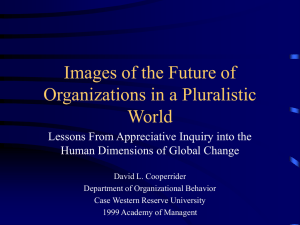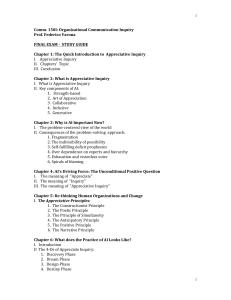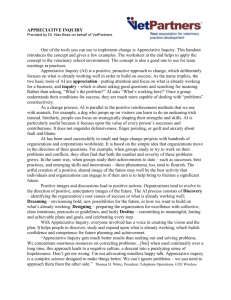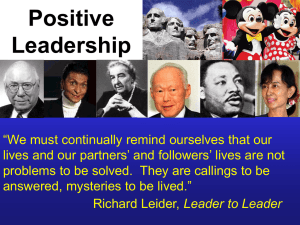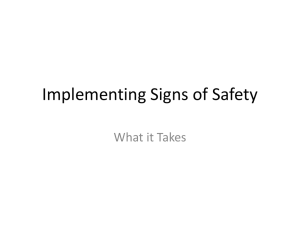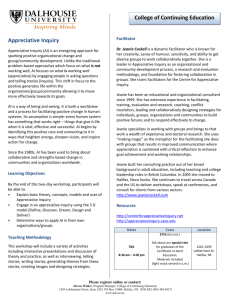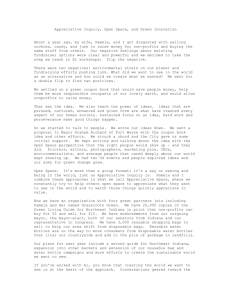An Introduction to Appreciative Inquiry
advertisement
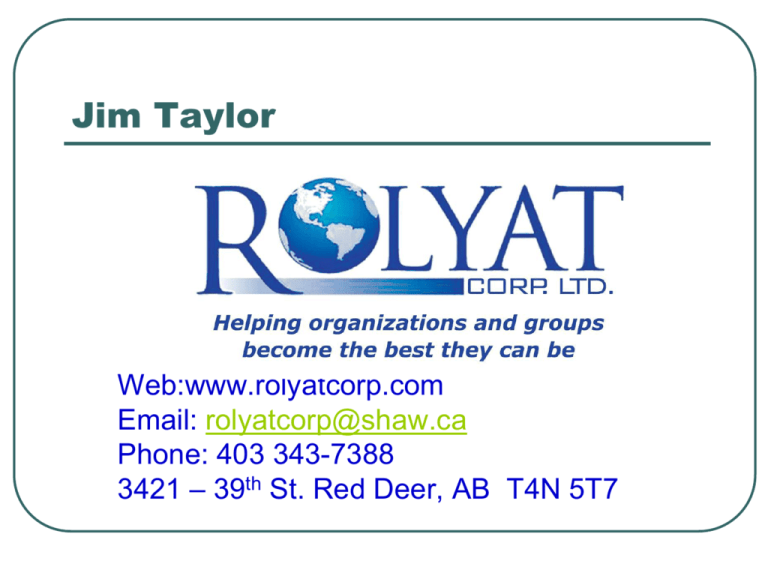
Jim Taylor Web:www.rolyatcorp.com Email: rolyatcorp@shaw.ca Phone: 403 343-7388 3421 – 39th St. Red Deer, AB T4N 5T7 Welcome! An Introduction to Appreciative Inquiry presented at Appreciative Inquiry is a positive, strength based alternative to problem solving as a means of initiating and managing change in organizations. Appreciative Inquiry “The study of what gives life to human systems when they are at their best.” A methodology for positive change An invitation to a positive revolution A process for whole system transformation (e.g. Avon Mexico) Why Should You be Interested? Appreciative Inquiry can help your organization create a better future by: Fully engaging the creativity and talent of your existing employees and volunteers Magnifying the speed at which you can execute positive innovations Creating an organizational culture that attracts the best and brightest talent (and volunteers!) to it. Two Approaches to Initiating/Managing Change Problem Solving Approach Asks: “What are the problems here?” Focuses on: Problems, deficiencies, what’s wrong, what’s broken, what isn’t working. Seeks “fixes” to problems. (A traditional role for management consultants.) “Appreciative” Approach Asks: “What works well here?” What is this organization like when it is at its best?” Focuses on: Peak experiences, best practices, life giving/life enriching forces. (This approach creates enormous positive momentum for change.) Appreciative Inquiry is based on the ancient wisdom that Whatever you focus your attention on GR OW S The Case of BP Pro Care 79% Customer Satisfaction Desire to improve… First they tried a “problem solving” approach: they held focus groups with “Dissatisfied” Customers The Case of BP Pro Care Using this approach: …the bottom dropped out Customer satisfaction plunged Staff morale plunged The Case of BP Pro Care The Appreciative Inquiry Alternative Interviews with satisfied customers “...Outstanding Customer Satisfaction Experience” Generative Benchmarking 95% fully satisfied customers after 8 months Because “whatever you focus your attention on grows” Appreciative Inquiry seeks to discover the root causes of success rather than the root causes of failure. The term “Appreciative Inquiry” comes from: “appreciate” to value or admire highly to recognize with gratitude to increase in value, like money in a good investment “inquiry” • to seek to understand through the asking of questions Appreciative Inquiry is used to make some existing positive quality in the organization “appreciate”, by systematically “inquiring” into where this quality already exists within the organization, even if it currently exists only in very small amounts. (e.g. Avon Mexico) Appreciative Inquiry is used to get “more” of something. It is not used to try to “get rid of” something (e.g. low morale, apathy, poor performance, dysfunctional organizational culture). What do you want more of in your organization? Employee and volunteer loyalty? Effective teamwork? Increased creativity and innovation? Better client service? High morale and enthusiasm for the job? Fiscal responsibility & accountability? Shared, inspiring leadership? Whatever positive quality you want “more of”, Appreciative Inquiry can help you get it by discovering where the quality already exists in your organization, and then leveraging this to create more. Ideally, an Appreciative Inquiry is like a 3-legged stool. 5 Generic Processes 1. Choose the positive as the focus of inquiry 2. Inquire into stories of life-giving forces 3. Locate themes that appear in the stories and select topics for further inquiry 4. Create shared images of a preferred future 5. Find innovative ways to create that future The 4D Model Global Excellence in Management Initiative British Airways Lost Baggage Given that whatever you focus your attention on grows, how to reframe? British Airways “Exceptional experiences” arrival Women feel devalued in this company. They complain about male coworkers' attitudes towards them, about workplace harassment, and about limits on the jobs available to them. What can we do about “machismo” attitudes? Who is harassing women and when are they doing it? What circumstances give rise to harassment? What kinds of harassment policies do we need? What is preventing women’s advancement in the company and how can we reduce the barriers? Women feel devalued in this company. They complain about male coworkers' attitudes towards them, about workplace harassment, and about limits on the jobs available to them. What are some examples of the very best experiences that men and women have had working together in this company, experiences that were very positive for both? What circumstances made these positive experiences possible? How can we recreate these conditions so that men and women have more "best" experiences working together? What can we do about “machismo” attitudes? Who is harassing women and when are they doing it? What circumstances give rise to harassment? What kinds of harassment policies do we need? What is preventing women’s advancement in the company and how can we reduce the barriers? Women feel devalued in this company. They complain about male coworkers' attitudes towards them, about workplace harassment, and about limits on the jobs available to them. Appreciative Inquiry is used to make some existing positive quality in the organization “appreciate”, by systematically “inquiring” into where this quality already exists within the organization, even if it currently exists only in very small amounts. (e.g. Avon Mexico) "When people are asked to participate in a change effort targeted at changing behaviors - specifically their behaviors they are ambivalent at best. When people are asked to bring their best forward for the benefit of the organization they do so with enthusiasm and pride." Diana Whitney, David Cooperrider, Maureen Garrison and Jean Moore in "Appreciative Inquiry and Culture Change at GTE: Launching a Positive Revolution" Developing an Appreciative Mindset Gervase Bushe www.gervasebushe.ca The Appreciative Self Tracking Fanning st 1 D - Discovery This is generally done using one on one interviews lasting between 1-2 hours Conscious decisions about “who interviews whom” can add great value to the process. Uses pre-written questionnaires st 1 D - Discovery Introductory Questions These lay the groundwork for story telling. They ask about: The person’s beginnings & attraction to the organization The person’s peak experiences since joining the organization The qualities the person values, both personal and organizational st 1 D - Discovery Topic Questions – There are usually 3 - 5 topics A positive preamble to introduce the topic Questions to elicit story telling about peak experiences related to the topic Concluding Questions Direct the interviewee’s attention to the future, and to what the organization is being “called” to become. They connect with the interviewee’s imagination and vision of the future. They ask about the “positive core” of the organization that should be preserved into the future. Time to Try It! Use Introductory Questions - conversation Overcoming Adversity – interview 90/10 Sometimes our greatest accomplishments result from challenges or adversity that we overcome. Tell me about a time when you overcame a significant challenge to achieve something noteworthy. What was the challenge? How did you overcome it? What positive results did you produce? How did this make you feel? How does it make you feel now, as you recall this episode? Debrief What was that like? Compiling and Handling the Data Interviews are summarized on “Interview Summary Forms” and distributed as widely as possible among organizational members prior to the “Dream” phase. nd 2 D – Dream – group activity Imagining the best possible future for the organization that is grounded in the very best of what has already been. A vision/image of that best possible future is collectively created. Organizations are not “pushed” by their past; they are “pulled” by the collective image they hold of their future. (The wake does not drive the boat!) “The Generative Metaphor Intervention” Medic Inn transformed organizational culture from one of suspicion, backbiting and negativity, into one of openness, cooperation and collaboration transformed the hotel from a 1 star to 4 star facility in one year Time to Try It! Create an image of your ideal future Dream/Imagine Imagine that every “problem” or “inadequacy” of your current organization is solved, and your organization is now in its best possible state. What does that look like? Draw some images on p. 5 RDPL AI Process One of the presentations created by a group at Red Deer Public Library to illustrate their vision of an ideal future for the library. Provocative Propositions Written in bold affirmative language in the present tense “provocative” – offer stretch and challenge, but are achievable Grounded in the best of “what is” Reflect people’s highest aspirations – they provoke passion Communication Red Deer Public Library We communicate openly, honestly, accurately and in a timely manner while being sensitive to the context and individuals involved. We recognize that individuals have different preferred methods of communication, and we accommodate these differences as much as possible. All staff have access to a single internal point of contact to communicate essential information. We provide appropriate channels to facilitate the free flow of information up, down and throughout the organization and to our external stakeholders. RDPL’s Action Steps Hold a 1-hour training session for the use of the blog – learn @ lunch Have sections on the blog for each department Use one or more of the monitors as an “info board” specifically for staff Have a computer in the staff room Designate the blog as the central source of info for staff – encourage its use. rd 3 D - Design “First we shape our structures and then our structures shape us.” Winston Churchill Design with an Appreciative Lens Appreciative Inquiry is an invitation to embed your most cherished values in the structures that guide individual and collective action – locally and globally. Designing with an Appreciative Lens It is an invitation to design the social architecture* of your organization or community so that your values are inevitable. * – the relationships, practices, programs, processes, products, services, policies, communications and technology The AI Design Process 1. 2. 3. Identify the elements of your social architecture that were most talked about in your discovery and dream activities. Consider the data – what did your discovery and dream activities say about the ideal for each element? Write a set of Design Principles that describe and affirm your ideals, that put your values into the elements you selected. Values-Based Organizational Design Value: Openness, Transparency Architecture: Executive Offices – First Floor, Glass Walls. Social Architecture: Meeting Participation – Open to one person from any other department, just had to rsvp in advance. Social Architecture: Financial Information – Open books to all employees. Values-Based Organizational Design Value: Human Well Being Architecture: Office Space – Secretaries’ desks by the windows; Managers’ offices on the inside walls since they spend most of their time away from their desks in meetings. Social Architecture: Executive Sabbatical – Each executive goes away from the company for 6 months every 5 years. th 4 D - Destiny How the energy and focus generated by the inquiry plays itself out over time. Ideally it helps to create an “appreciative learning culture” th 4 D - Destiny 5 Steps 1. 2. 3. 4. 5. Review, communicate and celebrate achievements to date to everyone in the organization For each provocative proposition, generate a list of all possible actions that will bring it into being Self organize for Inspired Action Projects Support Success of the Self Organized Projects Systematically apply AI to all aspects of the organization The Five Core Principles Defined The constructionist principle Social knowledge and community destiny are living, human constructions created through the conversations that we have with each other. "Reality is a negotiated interpretation." Shapiro & Carr, 1991 The five core principles defined: continued The principle of simultaneity Inquiry and change occur simultaneously . It is not the case that "first we do the analysis and then we decide on change." The very process of inquiry/analysis creates its own changes. The five core principles defined: continued The anticipatory principle Current behaviour is guided by images of the future. Organizations are not “pushed” by their past; (the wake does not drive the boat) they are “pulled” by the collective image they hold of their future. Self-fulfilling prophecy: ”Pygmalion effect”, “placebo” effect. The five core principles defined: continued The poetic principle Human organizations, including communities, are an open book, constantly being revised and co-authored. Its past, present and future are an endless source of learning, inspiration and interpretation. The five core principles defined: continued The positive principle The momentum for change requires positive thinking and social bonding-qualities like hope, inspiration and joy in creating with one another. Positive questions guide organizational development and foster long-lasting and effective changes. People, businesses, organizations and communities move in the direction of their questions. "What impact is my question having on our lives together ... is it helping to generate conversations about the good, the better, the possible ... is it strengthening our relationships?" “AI is based on a deceptively simple premise: that organizations grow in the direction of what they repeatedly ask questions about and focus their attention on. AI does not focus on changing people. Instead, it invites people to engage in building the kinds of organizations they want to live in. That’s hard to resist.” Gervase Bushe “Organizations, says AI theory, are centers of human relatedness, first and foremost, and relationships thrive where there is an appreciative eye – when people see the best in one another, when they share their dreams and ultimate concerns in affirming ways, and when they are connected in full voice to create not just new worlds, but better worlds.” Final Exercise – Mini Discovery What was your best experience or finest moment during the last 90 minutes? So……..! Go full speed ahead in the direction of your fondest hopes and dreams for the future or your organization. May all your new connections be positive connections! Thank you! Services Workshops – 1 hr. to full day • • A Four-hour workshop monthly at the Red Deer Chamber of Commerce (excluding July, Aug.) – partners for Edmonton & Calgary? Full day Conflict Resolution workshops Consulting – wide range, incl. performance evaluation using BARS and conflict resolution Research – lit reviews, internet research Writing (including proposals) and Editing
